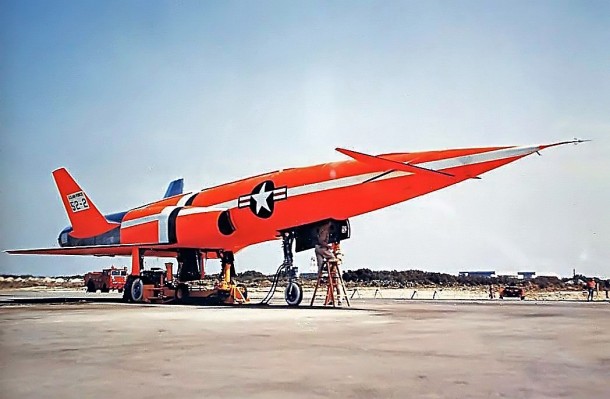
Fifty-nine years ago this month, the USAF/North American X-10 experimental flight research vehicle achieved a maximum speed of Mach 2.05 during its 19th test flight. The mark established a new speed record for turbojet-powered aircraft.
The precedent set by the Nazi V-1 and V-2 Vergeltungswaffen (Vengeance Weapons) in World War II motivated the United States to launch a post-war effort to develop a strategic range-capable missile capability. The earliest example in this regard was the USAF/North American Navaho (SM-64).
Known as Project MX-770, the Navaho was developmental effort to deliver a nuclear warhead at a range of 5,500 nm. The Navaho configuration consisted of a rocket-powered first stage and a winged second stage utilizing ramjet propulsion. The second stage was designed to cruise at Mach 2.75.
The X-10 was a testbed version of the Navaho second stage. The X-10 measured 66 feet in length, sported a wingspan of 28 feet and had a GTOW of 42,000 lbs. The sleek aircraft was powered by twin Westinghouse J40-WE-1 turbojets. These powerplants burned JP-4 and were each rated at 10,900 lbs of sea level thrust in full afterburner.
The X-10 was a double sonic-capable aircraft. It had an unrefueled range of 850 miles and a maximum altitude capability of 44,800 feet.
The X-10 vehicle flight surfaces included elevons for pitch and roll control and twin rudders for yaw control. Canard surfaces were employed for pitch trim. The aircraft was designed to take-off, maneuver and land under external control provided by either airborne or ground-based assets.
A total of thirteen (13) X-10 airframes were constructed by North American. Flight testing originated at the Air Force Flight Test Center (AFFTC), Edwards Air Force Base, California and later moved to the Air Force Missile Test Center (AFMTC) at Cape Canaveral in Florida.
There was a total of twenty-seven (27) X-10 flight tests. Fifteen (15) flight tests took place at the AFFTC between October of 1953 and March of 1955. Twelve (12) flight tests were conducted at the AFMTC between August 1955 and November 1956.
X-10 airframe GM-52-1 (GM-52-2 pictured above) achieved the highest speed of the type’s flight test series. On Wednesday, 29 February 1956, the aircraft recorded a peak Mach Number of 2.05 during the 19th flight test of the X-10 Program. At the time, this was a record for turbojet-powered aircraft. The record mission originated from and recovered to the runways at AFMTC.
While the X-10 Program produced a wealth of aerodynamic, structural, flight control and flight performance data, test vehicle attrition was extremely high. The lone X-10 to survive flight testing was airframe GM-19307. It is currently on display at the Museum of the United States Air Force at Wright-Patterson Air Force Base in Dayton, Ohio.
